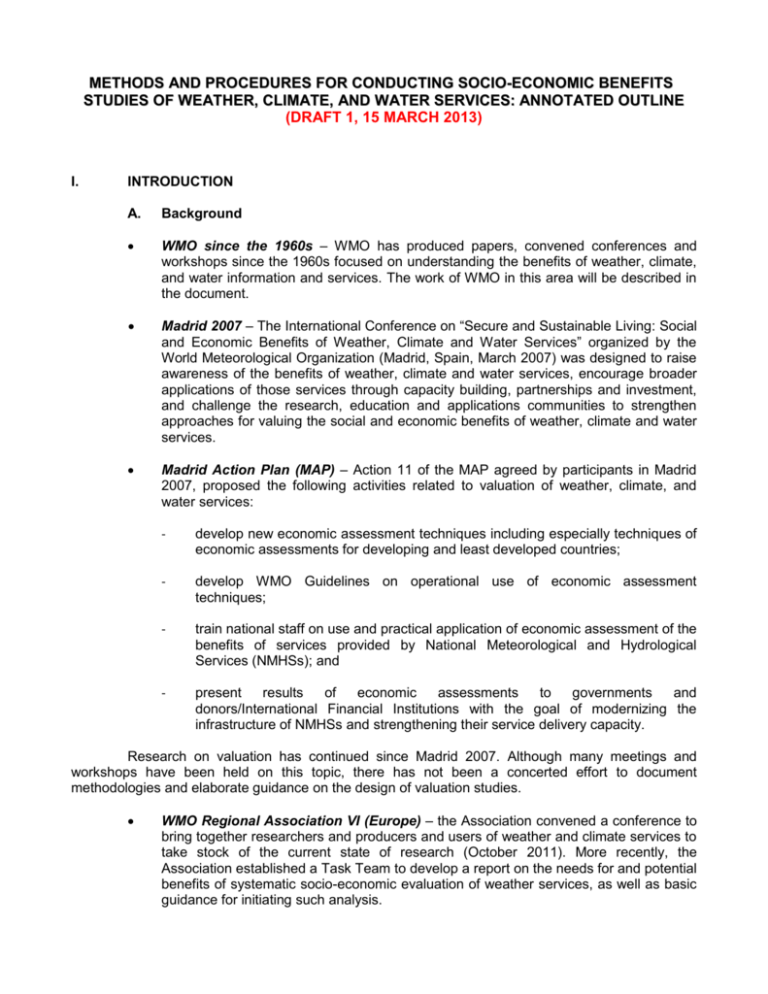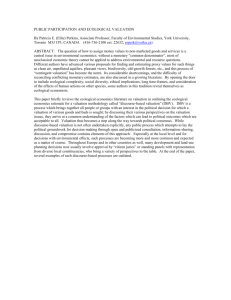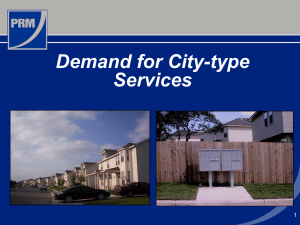methods and procedures for conducting socio-economic
advertisement

METHODS AND PROCEDURES FOR CONDUCTING SOCIO-ECONOMIC BENEFITS STUDIES OF WEATHER, CLIMATE, AND WATER SERVICES: ANNOTATED OUTLINE (DRAFT 1, 15 MARCH 2013) I. INTRODUCTION A. Background WMO since the 1960s – WMO has produced papers, convened conferences and workshops since the 1960s focused on understanding the benefits of weather, climate, and water information and services. The work of WMO in this area will be described in the document. Madrid 2007 – The International Conference on “Secure and Sustainable Living: Social and Economic Benefits of Weather, Climate and Water Services” organized by the World Meteorological Organization (Madrid, Spain, March 2007) was designed to raise awareness of the benefits of weather, climate and water services, encourage broader applications of those services through capacity building, partnerships and investment, and challenge the research, education and applications communities to strengthen approaches for valuing the social and economic benefits of weather, climate and water services. Madrid Action Plan (MAP) – Action 11 of the MAP agreed by participants in Madrid 2007, proposed the following activities related to valuation of weather, climate, and water services: - develop new economic assessment techniques including especially techniques of economic assessments for developing and least developed countries; - develop WMO Guidelines on operational use of economic assessment techniques; - train national staff on use and practical application of economic assessment of the benefits of services provided by National Meteorological and Hydrological Services (NMHSs); and - present results of economic assessments to governments and donors/International Financial Institutions with the goal of modernizing the infrastructure of NMHSs and strengthening their service delivery capacity. Research on valuation has continued since Madrid 2007. Although many meetings and workshops have been held on this topic, there has not been a concerted effort to document methodologies and elaborate guidance on the design of valuation studies. WMO Regional Association VI (Europe) – the Association convened a conference to bring together researchers and producers and users of weather and climate services to take stock of the current state of research (October 2011). More recently, the Association established a Task Team to develop a report on the needs for and potential benefits of systematic socio-economic evaluation of weather services, as well as basic guidance for initiating such analysis. -2- World Bank - the work of the Bank in socio-economic benefits of meteorological and hydrological services as part of modernization of NMHSs will be described and documented. Climate Services Partnership (CSP) – a global partnership, CSP, was launched in October 2011 at the International Conference on Climate Services in New York, United States of America. Under the CSP, a working group on the economic valuation of climate services (CSP/WG) has prepared a report covering more than 180 journal articles, papers, and reports covering valuation studies in developed and developing countries. The report describes the methods used in valuing climate services, presents the range of benefits evaluated in the studies, and highlights challenges in designing valuation studies. Others – to be added based on inputs from participants. Any study on the valuation of climate services will also be expected to provide a linkage to the Global Framework for Climate Services (GFCS) as it will highlight the benefits of climate services to the four pillars of GFCS (agriculture, health, water, and disaster risk reduction). II. B. Motivation for the Guidance Document In 2012, the WMO Executive Council (EC) requested the Secretariat to collaborate with the World Bank (WB) on a joint project to compile existing methodologies for socioeconomic benefits assessment of hydro-meteorological services, and to disseminate the results through an authoritative joint WMO-WB guidance document. In September 2012, at an informal meeting between WMO, the World Bank and the CSP/WG opportunities for collaboration on this work was discussed. It was decided to launch the preparation of the guidance document during a meeting of the WMO Forum on Social and Economic Applications and Benefits of Weather, Climate and Water Services in Geneva in April 2013. The meeting of the WMO Forum brought together researchers, donors, and producers and users of weather, climate and water services to take stock of valuation study design and methods and begin work on the guidance document. C. Objectives of the Guidance Document The guidance document describes a common framework for designing valuation studies covering assessments of both new (ex ante) and existing (ex post) weather and climate and water services. It provides a general overview of the various users of these services and the types of socio-economic benefits that are generated by these services and describes methodologies for valuing services. It also includes a focus on the role of decision-makers, users and beneficiaries in the design of studies and the communication of results. OVERVIEW OF SERVICES AND USERS A. Definitions – weather, climate and water services. B. Service users – understanding what constitutes “use” – is behavioral change required? How often does the service need to be accessed to constitute use? -3- C. III. IV. V. Matrix of services and users – Note: the CSP/WG initiated work on a matrix of services and users and would provide the starting point to develop this matrix. BENEFITS OF WEATHER, CLIMATE AND WATER SERVICES A. Economic benefits – increases in welfare (producer and consumer surplus), increased revenue and profits, reduced costs to produce commodities or public services, avoided damages, changes in prices and land values, reduced health care costs, reduced insurance premiums. B. Other benefits – reduced deaths, injuries, illness (associate with disasters), water savings, increases in crop yields. C. Survey of benefits from valuation studies – will draw from as many sources from the available literature as possible. These will include the work of WMO, WB, CSP, NCAR, user community, etc. VALUATION METHODS A. Market approaches: Production functions – e.g., crop simulations linked to market data/assumptions; Avoided costs/damages. B. Non-market approaches: Stated preference methods relying on willingness to pay surveys, such as contingent valuation and conjoint/stated choice method; Revealed preference methods. C. Benefits transfer – inferring value from studies in other sectors, countries. DESIGNING VALUATION STUDIES A. Problem Identification: Understanding the policy context for the valuation; How do decision-makers take decisions on new services or changes in existing services? What role does valuation play vis-à-vis, costs of services, implementation challenges (capacity to develop and sustain services, accessing information required to generate services, diffusion of new innovations – garnering trust, stochastic nature of weather, communicating benefits); B. Characterizing the service to be valued in terms of: Single service or suite of products; -4- Users of the service; Dissemination method(s) and rate of adoption anticipated or observed. C. Selecting the valuation method(s): considerations Nature of benefits; Type of analysis: new vs. existing service; Availability of performance data for existing services; Access to data; Time and resources available for study; Precision required by decision-makers and/or users. D. Valuation challenges: User capacity to process/benefit from probabilistic information; Attribution of benefits to services vis-à-vis other policy instruments (e.g., insurance, extension services, access to capital); Dealing with uncertainty and stochastic nature of benefits. E. Communicating results to users and decision-makers. ADDITIONAL MATERIAL FOR DOCUMENT: Examples: A collection of examples from work done by producers, users or researchers needs to be included in the document. Discussion Topics for the Workshop: 1. The review process – To be authoritative this work should be properly reviewed, the meeting needs to decide how and by whom since the reviewers need to be different from authors. So, some of the participants could be asked to be reviewers if they are not authors. 2. Discussions should also discuss what the final product will be and options for distribution and dissemination. A book? As well as on line? Costs of production and publication? __________






